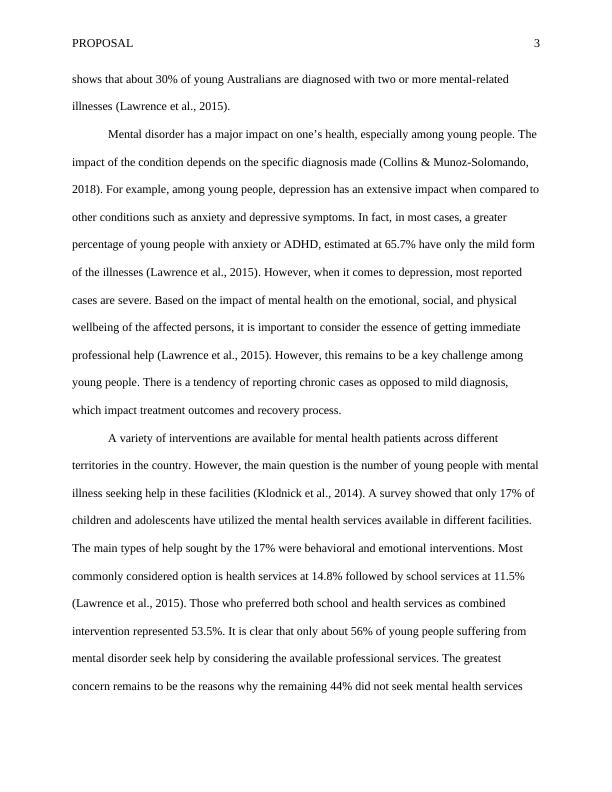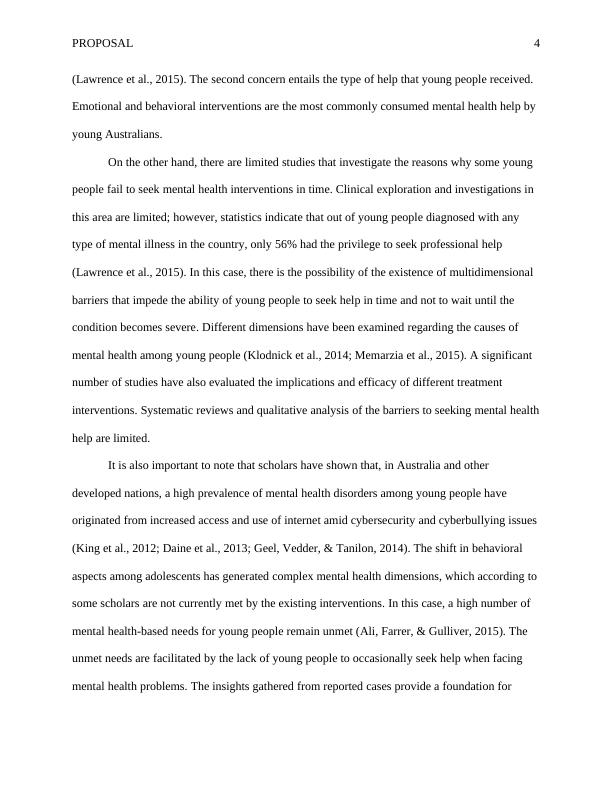Barriers to Seeking Mental Health Help and Adherence to Treatment Interventions among Australian Adolescents
Added on 2022-11-01
15 Pages4371 Words257 Views
Running head: PROPOSAL 1
Proposal
Student’s Name
Institutional Affiliation
Proposal
Student’s Name
Institutional Affiliation

PROPOSAL 2
Proposal
Introduction
Research plays a key role in healthcare development by offering evidence-based insights
that could be used to enhance service delivery and consumer experiences. Findings from
healthcare research have been used to develop policies, establish treatment guidelines, and
improve access to services for special and marginalized groups (Boaz et al., 2015). However, the
reliability and validity of the outcomes of health research depend on the extent to which the
study adhered to comprehensive and focused data collection, data analysis, and interpretation of
the findings (Boaz et al., 2015; Soper et al., 2015). This paper is a research proposal for health
research that intends to investigate the barriers that prevent Australian adolescents from seeking
mental health help and adhering to treatment interventions.
Background of the Study
About 13.9% of Australian children between the age of 4 and 17 are considered to be
suffering from a mental disorder (Lawrence et al., 2015). The percentage represents over half a
million children and adolescents in the country. The statistics imply that mental health among
young people in the country is a serious concern that requires comprehensive interventions
(Memarzia et al., 2015). Data specific to gender show that men are a higher risk of mental illness
when compared to their counterparts male at 16.3% and 11.5% respectively. In Australia, the
most common mental health problem among young people is Attention Deficit and Hyperactivity
Disorder (ADHD). Prevalence of ADHD among young people in the country stands at 7.4%.
Other complications include anxiety, depressive, and conduct disorders at 6.9%, 2.8%, and 2.1%
respectively (Lawrence et al., 2015). Another key indicator of mental health among adolescents
is the coexistence of several mental disorders in an individual. For example, clinical evidence
Proposal
Introduction
Research plays a key role in healthcare development by offering evidence-based insights
that could be used to enhance service delivery and consumer experiences. Findings from
healthcare research have been used to develop policies, establish treatment guidelines, and
improve access to services for special and marginalized groups (Boaz et al., 2015). However, the
reliability and validity of the outcomes of health research depend on the extent to which the
study adhered to comprehensive and focused data collection, data analysis, and interpretation of
the findings (Boaz et al., 2015; Soper et al., 2015). This paper is a research proposal for health
research that intends to investigate the barriers that prevent Australian adolescents from seeking
mental health help and adhering to treatment interventions.
Background of the Study
About 13.9% of Australian children between the age of 4 and 17 are considered to be
suffering from a mental disorder (Lawrence et al., 2015). The percentage represents over half a
million children and adolescents in the country. The statistics imply that mental health among
young people in the country is a serious concern that requires comprehensive interventions
(Memarzia et al., 2015). Data specific to gender show that men are a higher risk of mental illness
when compared to their counterparts male at 16.3% and 11.5% respectively. In Australia, the
most common mental health problem among young people is Attention Deficit and Hyperactivity
Disorder (ADHD). Prevalence of ADHD among young people in the country stands at 7.4%.
Other complications include anxiety, depressive, and conduct disorders at 6.9%, 2.8%, and 2.1%
respectively (Lawrence et al., 2015). Another key indicator of mental health among adolescents
is the coexistence of several mental disorders in an individual. For example, clinical evidence

PROPOSAL 3
shows that about 30% of young Australians are diagnosed with two or more mental-related
illnesses (Lawrence et al., 2015).
Mental disorder has a major impact on one’s health, especially among young people. The
impact of the condition depends on the specific diagnosis made (Collins & Munoz-Solomando,
2018). For example, among young people, depression has an extensive impact when compared to
other conditions such as anxiety and depressive symptoms. In fact, in most cases, a greater
percentage of young people with anxiety or ADHD, estimated at 65.7% have only the mild form
of the illnesses (Lawrence et al., 2015). However, when it comes to depression, most reported
cases are severe. Based on the impact of mental health on the emotional, social, and physical
wellbeing of the affected persons, it is important to consider the essence of getting immediate
professional help (Lawrence et al., 2015). However, this remains to be a key challenge among
young people. There is a tendency of reporting chronic cases as opposed to mild diagnosis,
which impact treatment outcomes and recovery process.
A variety of interventions are available for mental health patients across different
territories in the country. However, the main question is the number of young people with mental
illness seeking help in these facilities (Klodnick et al., 2014). A survey showed that only 17% of
children and adolescents have utilized the mental health services available in different facilities.
The main types of help sought by the 17% were behavioral and emotional interventions. Most
commonly considered option is health services at 14.8% followed by school services at 11.5%
(Lawrence et al., 2015). Those who preferred both school and health services as combined
intervention represented 53.5%. It is clear that only about 56% of young people suffering from
mental disorder seek help by considering the available professional services. The greatest
concern remains to be the reasons why the remaining 44% did not seek mental health services
shows that about 30% of young Australians are diagnosed with two or more mental-related
illnesses (Lawrence et al., 2015).
Mental disorder has a major impact on one’s health, especially among young people. The
impact of the condition depends on the specific diagnosis made (Collins & Munoz-Solomando,
2018). For example, among young people, depression has an extensive impact when compared to
other conditions such as anxiety and depressive symptoms. In fact, in most cases, a greater
percentage of young people with anxiety or ADHD, estimated at 65.7% have only the mild form
of the illnesses (Lawrence et al., 2015). However, when it comes to depression, most reported
cases are severe. Based on the impact of mental health on the emotional, social, and physical
wellbeing of the affected persons, it is important to consider the essence of getting immediate
professional help (Lawrence et al., 2015). However, this remains to be a key challenge among
young people. There is a tendency of reporting chronic cases as opposed to mild diagnosis,
which impact treatment outcomes and recovery process.
A variety of interventions are available for mental health patients across different
territories in the country. However, the main question is the number of young people with mental
illness seeking help in these facilities (Klodnick et al., 2014). A survey showed that only 17% of
children and adolescents have utilized the mental health services available in different facilities.
The main types of help sought by the 17% were behavioral and emotional interventions. Most
commonly considered option is health services at 14.8% followed by school services at 11.5%
(Lawrence et al., 2015). Those who preferred both school and health services as combined
intervention represented 53.5%. It is clear that only about 56% of young people suffering from
mental disorder seek help by considering the available professional services. The greatest
concern remains to be the reasons why the remaining 44% did not seek mental health services

PROPOSAL 4
(Lawrence et al., 2015). The second concern entails the type of help that young people received.
Emotional and behavioral interventions are the most commonly consumed mental health help by
young Australians.
On the other hand, there are limited studies that investigate the reasons why some young
people fail to seek mental health interventions in time. Clinical exploration and investigations in
this area are limited; however, statistics indicate that out of young people diagnosed with any
type of mental illness in the country, only 56% had the privilege to seek professional help
(Lawrence et al., 2015). In this case, there is the possibility of the existence of multidimensional
barriers that impede the ability of young people to seek help in time and not to wait until the
condition becomes severe. Different dimensions have been examined regarding the causes of
mental health among young people (Klodnick et al., 2014; Memarzia et al., 2015). A significant
number of studies have also evaluated the implications and efficacy of different treatment
interventions. Systematic reviews and qualitative analysis of the barriers to seeking mental health
help are limited.
It is also important to note that scholars have shown that, in Australia and other
developed nations, a high prevalence of mental health disorders among young people have
originated from increased access and use of internet amid cybersecurity and cyberbullying issues
(King et al., 2012; Daine et al., 2013; Geel, Vedder, & Tanilon, 2014). The shift in behavioral
aspects among adolescents has generated complex mental health dimensions, which according to
some scholars are not currently met by the existing interventions. In this case, a high number of
mental health-based needs for young people remain unmet (Ali, Farrer, & Gulliver, 2015). The
unmet needs are facilitated by the lack of young people to occasionally seek help when facing
mental health problems. The insights gathered from reported cases provide a foundation for
(Lawrence et al., 2015). The second concern entails the type of help that young people received.
Emotional and behavioral interventions are the most commonly consumed mental health help by
young Australians.
On the other hand, there are limited studies that investigate the reasons why some young
people fail to seek mental health interventions in time. Clinical exploration and investigations in
this area are limited; however, statistics indicate that out of young people diagnosed with any
type of mental illness in the country, only 56% had the privilege to seek professional help
(Lawrence et al., 2015). In this case, there is the possibility of the existence of multidimensional
barriers that impede the ability of young people to seek help in time and not to wait until the
condition becomes severe. Different dimensions have been examined regarding the causes of
mental health among young people (Klodnick et al., 2014; Memarzia et al., 2015). A significant
number of studies have also evaluated the implications and efficacy of different treatment
interventions. Systematic reviews and qualitative analysis of the barriers to seeking mental health
help are limited.
It is also important to note that scholars have shown that, in Australia and other
developed nations, a high prevalence of mental health disorders among young people have
originated from increased access and use of internet amid cybersecurity and cyberbullying issues
(King et al., 2012; Daine et al., 2013; Geel, Vedder, & Tanilon, 2014). The shift in behavioral
aspects among adolescents has generated complex mental health dimensions, which according to
some scholars are not currently met by the existing interventions. In this case, a high number of
mental health-based needs for young people remain unmet (Ali, Farrer, & Gulliver, 2015). The
unmet needs are facilitated by the lack of young people to occasionally seek help when facing
mental health problems. The insights gathered from reported cases provide a foundation for

End of preview
Want to access all the pages? Upload your documents or become a member.
Related Documents
Depression among Adolescents in Australialg...
|13
|2450
|183
Mental Health Disorders in Australialg...
|12
|2850
|279
Alcohol Use Disorder (AUD) | Literature Reviewlg...
|8
|2039
|25
Development of Mental Health Across Lifespanlg...
|4
|779
|190
Effectiveness of Mental Health Promoting Interventions for Young Adults: A Literature Reviewlg...
|6
|1104
|417
Public Health Assignment (Doc)lg...
|13
|3381
|99
